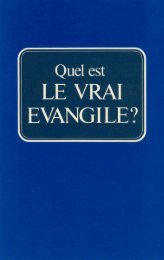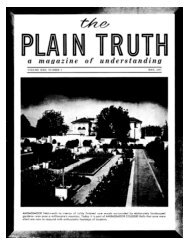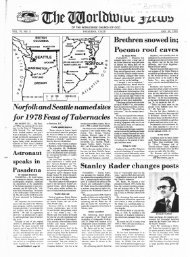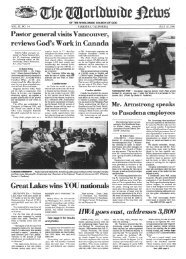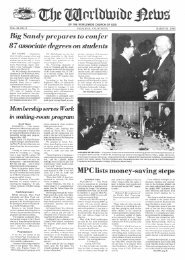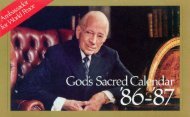The Biblical Basis of the Sacred Calendar Part One
The Biblical Basis of the Sacred Calendar Part One
The Biblical Basis of the Sacred Calendar Part One
You also want an ePaper? Increase the reach of your titles
YUMPU automatically turns print PDFs into web optimized ePapers that Google loves.
FOOTNOTES<br />
1. In Rabbinic Hebrew, such a new crescent is called yareach ben yomo (in English idiom, "a dayold<br />
moon").<br />
2. "In <strong>the</strong> region <strong>of</strong> Jerusalem...shortly before <strong>the</strong> autumnal [fall) equinox <strong>the</strong> minimum interval from<br />
<strong>the</strong> true conjunction to <strong>the</strong> phasis [new crescent] is approximately 20 hours, while <strong>the</strong> maximum is<br />
close to 72 hours, with <strong>the</strong> minimum <strong>of</strong> approximately 18 hours shortly before <strong>the</strong> vernal [spring]<br />
equinox and <strong>the</strong> various respective maxima and minima throughout <strong>the</strong> year" ("<strong>Calendar</strong>",<br />
Encyclopedia Judaica, col. 46).<br />
3. <strong>The</strong> Babylonians and Persians began <strong>the</strong> months with <strong>the</strong> new crescent in <strong>the</strong>ir lunisolar<br />
calendar, and some Jews -- particularly <strong>the</strong> Pharisees and early Rabbis, but also <strong>the</strong> Karaites --<br />
followed <strong>the</strong>ir example. <strong>The</strong>ir confusion <strong>of</strong> biblical and Babylonian principles has led some to look to<br />
<strong>the</strong> Babylonian calendar as a guide to reconstructing <strong>the</strong> original Hebrew calendar!<br />
4. <strong>The</strong> timing and position <strong>of</strong> <strong>the</strong> new crescent depend on <strong>the</strong> interval <strong>of</strong> time from <strong>the</strong> true<br />
conjunction (i.e., <strong>the</strong> astronomical new moon) to sunset, <strong>the</strong> season <strong>of</strong> <strong>the</strong> year, <strong>the</strong> moon's position<br />
above or below <strong>the</strong> ecliptic (<strong>the</strong> yearly path <strong>of</strong> <strong>the</strong> sun), and <strong>the</strong> observer's geographical location<br />
("<strong>Calendar</strong>", Judaica, col. 45).<br />
5. As justification for <strong>the</strong> very long lives <strong>of</strong> <strong>the</strong> ancients, Josephus states <strong>the</strong> following: "God afforded<br />
<strong>the</strong>m a longer time <strong>of</strong> life on account <strong>of</strong> <strong>the</strong>ir virtue and <strong>the</strong> good use <strong>the</strong>y made <strong>of</strong> it in astronomical<br />
and geometrical discoveries, which would not have afforded <strong>the</strong> time <strong>of</strong> foretelling [<strong>the</strong> periods <strong>of</strong> <strong>the</strong><br />
stars] unless <strong>the</strong>y had lived six hundred years; for <strong>the</strong> Great Year is completed in that interval"<br />
(Antiquities <strong>of</strong> <strong>the</strong> Jews, Bk. III, ch. 9 (106), translated by William Whiston). <strong>The</strong> "Great Year" is <strong>the</strong><br />
cycle <strong>of</strong> years determined by <strong>the</strong> oppositions <strong>of</strong> Jupiter and Saturn. However, though Josephus<br />
mentions it as common knowledge to ancient scholars, he does not link it to <strong>the</strong> sacred calendar.<br />
6. This does not mean <strong>the</strong> benchmark <strong>of</strong> <strong>the</strong> Jewish calendar actually dates back to Creation Week.<br />
<strong>The</strong> current "world era" <strong>of</strong> Judaism (Year <strong>One</strong> = 3761 BC) is based on a misreckoning <strong>of</strong> biblical<br />
chronology. For example, it counts 892 years "from Noah to Abraham". What it actually counts is <strong>the</strong><br />
number <strong>of</strong> years from Noah's birth to Terah's 70th year. Yet a comparison <strong>of</strong> Genesis 11:26, 32 and<br />
12:4 with Acts 7:4 shows Abraham must have been born no less than 60 years later.<br />
7. Suzanne Haik-Vantoura <strong>of</strong> Paris deciphered <strong>the</strong>se "musical accents". <strong>The</strong> first edition <strong>of</strong> her<br />
French book was published in 1976; <strong>the</strong> second edition (1978) was translated in 1991 as <strong>The</strong> Music<br />
<strong>of</strong> <strong>the</strong> Bible Revealed (BIBAL Press/King David's Harp, Inc.). In any case, <strong>the</strong> comma after<br />
"appointed times" is dictated by <strong>the</strong> "grammatical rules" post-imposed upon <strong>the</strong> notation by Rabbinic<br />
Judaism, as well as by Haik-Vantoura's musical "deciphering key". (For fur<strong>the</strong>r information on Haik-<br />
Vantoura's discovery, <strong>the</strong> reader may visit http://www.kingdavidsharp.com/ and<br />
http://<strong>the</strong>song<strong>of</strong>songs.tripod.com/.)<br />
8. This is apparently why <strong>the</strong> "Documentary Hypo<strong>the</strong>sis" claims this verse comes from a "priestly"<br />
(P) source. Cf. <strong>The</strong> New Brown-Driver-Briggs-Genesius Hebrew-Aramaic Lexicon, 1979, pp. 17a,<br />
417b.<br />
9. Lunar eclipses are especially valuable for <strong>the</strong> calendar maker, because <strong>the</strong>y can be observed by<br />
everyone on <strong>the</strong> night side <strong>of</strong> <strong>the</strong> earth at <strong>the</strong> same "world time". Solar eclipses, on <strong>the</strong> o<strong>the</strong>r hand,<br />
can only be observed by a few people on <strong>the</strong> day side <strong>of</strong> earth; and every observer sees <strong>the</strong> eclipse<br />
at a different "local time" as well as a different "world time".<br />
10. Solar eclipses (especially total ones) point (in <strong>the</strong>ory if not in practice) to <strong>the</strong> astronomical true<br />
conjunction. Unfortunately, during a total solar eclipse <strong>the</strong>re is but one point on <strong>the</strong> path <strong>of</strong> <strong>the</strong><br />
moon's shadow across <strong>the</strong> earth where one may actually observe <strong>the</strong> moment <strong>of</strong> true conjunction.<br />
11. <strong>The</strong> astronomical mean conjunction is in principle (if no longer in exact timing) <strong>the</strong> same as <strong>the</strong><br />
calculated molad. Cumulative errors in <strong>the</strong> calculations <strong>of</strong> <strong>the</strong> sacred calendar and perturbations in<br />
<strong>the</strong> lunar and planetary orbits ensure that <strong>the</strong> two no longer coincide exactly.<br />
12. "Owing to inequalities in <strong>the</strong> rate <strong>of</strong> both <strong>the</strong> solar and <strong>the</strong> lunar motion in longitude, <strong>the</strong> mean




